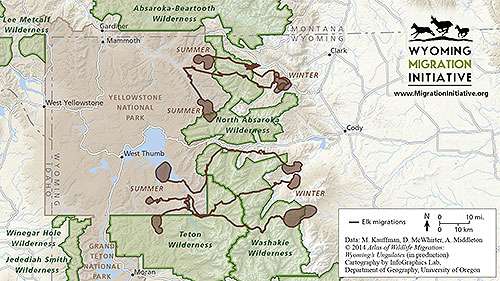New mapping project details big game migrations in Wyoming wilderness

Designated wilderness areas provide important habitat for five of Wyoming's migratory big-game species, according to a first-of-its-kind mapping project involving wildlife researchers at the University of Wyoming and cartographers at the University of Oregon.
In new maps highlighted in a short film released today (Wednesday), the researchers detail how elk, mule deer, moose, bighorn sheep and pronghorn all use Wyoming and Colorado wilderness areas, mostly as high-country summer range. It's the first time that these migration corridors have been mapped to specifically see how animals use wilderness areas.
"We have known for years that undeveloped habitat is crucial for the West's iconic big game species, but this new compilation of data shows in detail the extent to which these animals migrate through habitats designated as wilderness," says Matthew Kauffman, a UW professor who led the effort. "As we mark the 50th anniversary of the Wilderness Act, this information illustrates the benefits of those actions taken five decades ago for these important wildlife species and the migration corridors they depend on today."
Wyoming's Big Game Migrations and 50 Years of Wilderness from Biodiversity Institute on Vimeo.
The mapping project is part of the Atlas of Wildlife Migration, a comprehensive, ongoing effort to document the historical and current long-distance migrations of big game species between summer and winter ranges in Wyoming. Using modern GPS collars to follow the animals and new cartographic techniques, the Wyoming Migration Initiative, which Kauffman directs, conducts research and outreach to better understand and conserve Wyoming's ungulate migrations. While big-game migrations are being lost worldwide, many still remain intact in the vast open landscapes of Wyoming, the nation's least populated state.
Using innovative cartographic methods and tools, the team at the UO InfoGraphics Lab visualizes the detailed GPS data in maps that clearly communicate the newly discovered routes and movement patterns within the complex landscapes through which the animals migrate.
"Creating compelling maps that get at the heart of these magnificent migration stories is our goal as the cartographers on this project," says James Meacham, executive director of the UO InfoGraphics Lab.
Specifically, the new findings show that:
- Elk moving to and from summer range in Yellowstone National Park migrate extensively through the Teton, Washakie and North Absaroka wilderness areas in the Shoshone and Bridger-Teton national forests.
- Also in the greater Yellowstone area, moose that winter east of Jackson Lake move north into and through the Teton wilderness area on their spring migration.
- Bighorn sheep migrate through and spend summers in the Bridger and Fitzpatrick wilderness areas south of Dubois.
- Pronghorn migrate north from the Green River Basin to summer in and near the Gros Ventre wilderness.
- And mule deer that winter in the Platte Valley move south through the Huston Park, Savage Run, Encampment River, Platte River and Mount Zirkel wilderness areas in southern Wyoming and northern Colorado during their seasonal migrations.
"Without migration, Wyoming would not be able to support nearly as many big game as we have today. These animals have it hard enough as it is, and any sort of human development affects their health and numbers. Wilderness provides a sanctuary by minimizing human impacts," says Zach McDermott of Jackson, an avid hunter in the Bridger-Teton National Forest. "Backcountry hunting is a long-standing tradition and an important economic driver for the state, and designated wilderness makes it possible for that tradition to continue."
The Wilderness Act of 1964 created the Bridger and Teton wilderness areas in the Bridger-Teton National Forest and the North Absaroka and the South Absaroka (now called the Washakie) wilderness areas in the Shoshone National Forest.
This year also is the 30th anniversary of the Wyoming Wilderness Act. Sponsored by then-U.S. Sens. Alan Simpson and Malcolm Wallop and then-U.S. Rep. Dick Cheney, the Wyoming act established eight more Wyoming wilderness areas, including Cloud Peak, Popo Agie, Gros Ventre and Jedediah Smith. In a retrospective piece earlier this year, Cheney described the 1984 bill as the most important legislation he sponsored for Wyoming during his time in Congress.
While emphasizing the importance of designated wilderness in this current mapping effort, the Wyoming Migration Initiative researchers note that private, state and non-wilderness federal lands also are critical for migrating animals in the region. The recently discovered Red Desert-to-Hoback mule deer migration, for example, begins in the spring on Bureau of Land Management lands of Wyoming's Red Desert, extends across the foothills of the Wind River Mountains on both public and private lands, and ends with deer finally arriving on summer range in the Gros Ventre wilderness area after a one- to two-month journey of 150 miles.
"To assure the future health of these herds, land managers and others must look at ways to keep these migration corridors intact across a variety of landscapes, not just wilderness," Kauffman says. "The goal of this new mapping effort, and the short film, is to make research about these migrations more accessible—and more useful—to people working to manage and conserve these herds and their habitats."
Provided by University of Wyoming



















